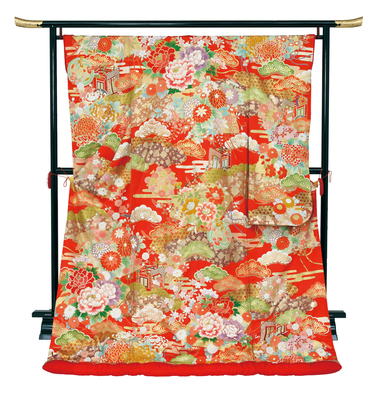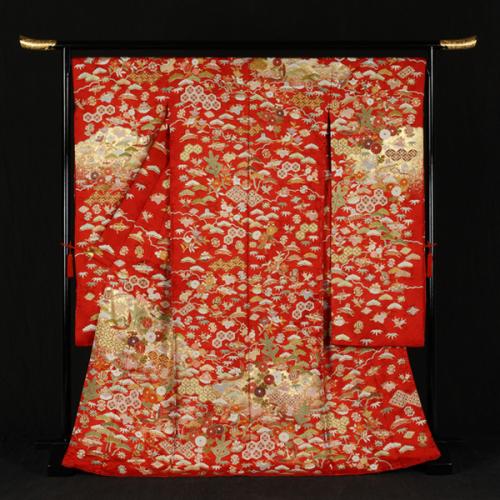
- Dyed textiles
- Kyoto
Kyo textiles Kyo yuzen
A medley of bright colors
in the natural and elegant world of Kyoto
Description
What is Kyo textiles ?
Kyo textiles are dyed textiles made throughout Kyoto prefecture that feature a wide range of vivid colors and a technique of pictorial designs of animals, nature and daily items called yuzenmoyo.
The dyeing method is very unique as artisans put glue around the outlines of the patterns to prevent the color from running and getting mixed up with the other patterns. Since this traditional handwork is an intensive and expensive labor, another simplified technique has more recently become popular.
Besides Kyo textiles, another pattern dyeing style called Kaga textiles from the Ishikawa prefecture is also well known for its splendid five color palettes, Kaga gosai. However Kaga textiles does not indulge itself in the rich embroidery and gold leaf decoration like Kyo does.
This splendid Kyo textile is a beautiful production by the elegant and sumptuous culture of Kyoto and it is popular not only in Japan but all over the world.
History
During the Edo period (1603-1868), a famous fan painter named Yuzensai MIYAZAKI established a new style of dyeing method called Kyo yuzen (Kyo textiles in Japanese). The technique of pattern drawing on a folding fan is believed to be the inspiration behind Kyo textiles.
Generally speaking, the history of dyeing dates back to the Nara period (710-794), at the dawn of Japan's culture, and since then it has continuously developed to another form of dyeing like batik (resist dyeing).
In the early Muromachi period (1336-1573), the luxurious sarasa (chintz in English) and gold foil embroidery dyeing methods were incorporated which built up the original dyeing culture of Kyoto and established it as a noteworthy region.
In the mid-Edo period, brilliantly colorful and pictorial kimono gained popularity among the chonin (rising middle class), and yuzen dyeing became a huge trend. It is believed that, in those days, the different dyeing techniques and skills were combined, resulting in the current dyeing method.
With the introduction of chemical dye during the Meiji period (1868-1912), a technique of mixing the dye with paste to make a colored dyeing paste was developed. The colored dyeing paste was applied during the yuzen dyeing process of tracing designs from paper patterns. Jisuke HIROSE was a key innovator of this new technique and he helped further advance the art of yuzen dyeing.
Production Process
- 1. Sketching
The whole production process of Kyo textiles requires an extended period of time as it involves the collaboration of many specialized artisans with high craftsmanship.
At first, the design is made. A designer draws a rough sketch and adapts the patterns to the actual scale of the kimono. Then the sketch will be drawn onto a large kimono that has been basted or stitched temporarily. A washable ink meant for drafting called aobana is used to draw the rough sketch onto the kimono.
- 2. Starching
The outlines of the design are drawn in with a glue called itome-nori, which is used as a mask to prevent the application of dyes that are to be applied during a later step. After starching, the lines are washed out and the cloth is stretched out. A soybean broth called gojiru is applied as a base coat. It is then immediately set over a fire to dry.
This process helps the glue soak into the fabric and ensures that the dyes are applied smoothly during a later stage.
- 3. Coloring
The dyes are applied to the starched outline of patterns on the cloth. The cloth is dried with an electric heater or charcoal brazier while color is applied with brushes.
Performing the dye application is a skill akin to painting on a canvas and it can take years to master the precise technique of blending tones and colors.
- 4. Wax application
During this step, starch or wax is applied to the colored patterns to prevent them from being dyed when the base color is applied to the textile. A brush is used most often but there are many other techniques such as gradation or double dyeing.
When the dyeing is completed on the entire fabric, it is then steamed. All the excess product including the glue is washed out after steaming the fabric. There is then even more washing, stretching, and steam ironing to give the cloth a smooth, silky touch.
The final washing (known as yuzen nagashi) was a popular event among Kyoto townspeople because it used to be done in the beautiful local rivers like Kamogawa and Horikawa.
- 5. Finishing touches
As a finishing touch, decorations such as gold and platinum leaves, gold and silver dust, or rich embroidery are applied. Gold embellishing is a technique of placing gold leaves and dust on a glued surface. Many other techniques have been developed, such as itome starching, stamp dyeing, and variations of gold and silver embossing like wide cutting, slicing, dusting, beating, and rubbing.
By adding embroidery, a brightly colored kimono becomes even more beautiful and splendid.
Although pattern dyeing and direct printing are widespread today, the traditions of delicate yuzen dyeing are preserved and still popular especially for formal kimono like furisode (long sleeved kimono for girls) and tomesode (short sleeved kimono for married women).
Representative Manufacturers
SAIRIN Co., Ltd.

Our fabric dyeing expert artisans create Kyoto textiles in the respect of traditions and techniques.
We wish to create Kyoto textiles that reflect Kyoto's beauty and sensitivity for modern-days individuals.
-
Founded1960
-
ClosedNot fixed
-
DirectorTomoko Fujii
-
Address
-
Website
-
Tel.+81-75-221-6088
Facility Information
Kyoto Museum of Crafts and Design

-
Address
-
Tel.+81-75-762-2670
-
ClosedDecember 29 to January 3
-
Business Hours9am to 5pm
-
Website
Related Artists
- You will be redirected to the artist's page on the Gallery Japan website
Other Dyed textiles
- Kaga textiles
- Kyo textiles
- Tokyo fine-patterned dyeing
- Nagoya textiles
- Kyo-komon textiles
- Arimatsu tie-dyeing
- Ryukyu traditional textiles
- Tokyo textiles
- Kyo dyed textiles
- Nagoya kimono-dyeing
- Kyo kimono-dyeing
- Naniwa Honzome Hand Dyeing
- Tokyo Honzome Chusen
- Tokyo Plain Dyeing































































































































































































































































































